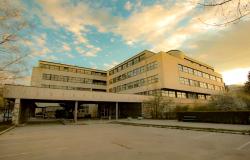UNSA Scientists Achieved Top Result: Fetić and Milošević Published Their Work in Physical Review Letters

The paper High-order phase-dependent asymmetry in the above-threshold ionization plateau https://link.aps.org/doi/10.1103/PhysRevLett.126.113201 coauthored by Doz. Dr. Benjamin Fetić and academician Prof. Dr. Dejan Milošević UNSA Faculty of natural Sciences and Mathematics, Department of Physics, was published on 17 March 2021 in the American journal Physical Review Letters, the best journal in physics in which short papers are published (Letters; impact factor 8,385). The published work is the result of the cooperation of our scientists with two experimental scientific research groups, from Jena, Germany, and from Szeged, Hungary.
The experiment was performed at the ELI-ALPS plant in Szeged, Hungary, which is part of a European scientific infrastructure worth over 850 million euros, dedicated to powerful sources of ultrashort laser pulses and research into electron dynamics in atoms, molecules, plasma and condensed matter on the atomic time scale. Theoretical calculations and simulation of the experiment were performed on computer equipment (Beowulf cluster with 88 CPU cores and over 200 GB of RAM and Dell PowerEdge R940 server with 80 CPU cores and 256 GB of RAM) Department of Atomic, Molecular and Optical Physics for Physics in Sarajevo. In addition to the simulation of the experiment, the contribution of scientists from Sarajevo is a physical explanation of the newly discovered process, as well as extensive additional material in which the theory used to simulate and explain the results of the experiment is presented in detail.
Symmetries and symmetry breaking are of special importance in physics, especially in nonlinear optics. Disruption of the spatial symmetry of the photoelectron spectrum by means of the asymmetric shape of the laser pulse has been an active area of research in strong field physics for years. All previous experiments have shown that, according to intuition, the asymmetry of the photoelectron spectrum follows the phase hangs in a sinusoidal manner. In this paper, results are obtained that are contrary to this intuition. The observed high-frequency oscillations are explained using analogy with electron orbits and time-type holography. A perspective is open for new experiments with atoms, molecules and more complex structures.







